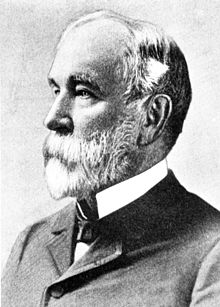Edward C. Cabell
Edward C. Cabell | |
|---|---|
 | |
| Member of the U.S. House of Representatives from Florida's at-large district | |
| In office October 6, 1845 – January 24, 1846 | |
| Preceded by | none |
| Succeeded by | William H. Brockenbrough |
| In office March 4, 1847 – March 3, 1853 | |
| Preceded by | William H. Brockenbrough |
| Succeeded by | Augustus Maxwell |
| Personal details | |
| Born | February 5, 1816 Richmond, Virginia |
| Died | February 28, 1896 (aged 80) St Louis, Missouri |
| Resting place | Bellefontaine Cemetery[1] St Louis, Missouri |
| Political party | Whig |
| Spouse | Anna Marie Wilcox |
| Alma mater | University of Virginia |
| Profession | Lawyer |
| Military service | |
| Allegiance | |
| Branch/service | |
| Years of service | 1862-1865 |
| Rank | |
| Unit | Major General Sterling Price's Staff[2][3] |
| Battles/wars | American Civil War |
Edward Carrington Cabell (February 5, 1816 – February 28, 1896) was the first US Representative from Florida.
Biography
Born in Richmond, Virginia; attended Washington College (now Washington and Lee University), Lexington, Virginia in 1832 and 1833 and Reynolds' Classical Academy in 1833 and 1834; was graduated from the University of Virginia at Charlottesville, Virginia in 1836; moved to Florida in 1837 and engaged in agricultural pursuits near Tallahassee, Florida.[4]
Delegate to the Territorial convention to form a State constitution in 1838; returned to Virginia; studied law; was admitted to the bar in 1840; returned to Tallahassee, Fla.; upon the admission of Florida as a State into the Union presented credentials as a Member-elect to the Twenty-ninth United States Congress and served from October 6, 1845, to January 24, 1846, when he was succeeded by William H. Brockenbrough, who contested the election; elected as a Whig to the Thirtieth, Thirty-first, and Thirty-second Congresses (March 4, 1847 – March 3, 1853); chairman of the Committee on Expenditures on Public Buildings (Thirtieth-Congress); unsuccessful candidate in 1852 for reelection to the Thirty-third Congress.[4]
Resumed the practice of law in Tallahassee; moved to St. Louis, Missouri in 1859, In May–June 1861 served as Missouri Governor C. F. Jackson's secret Commissioner (Ambassador) to the Confederate Government. Subsequently, during the American Civil War served in the Confederate Army[2][3] with rank of lieutenant colonel; engaged in the practice of law in New York City 1868–1872, and subsequently in St. Louis, Mo.; member of the State senate of Missouri 1878–1882; died in St. Louis, Mo.; interment in Bellefontaine Cemetery.[4]
Notes
- ^ "Edward Carrington Cabell". Find A Grave. Retrieved 4 February 2018.
- ^ a b Banasik, Michael (2010). Confederate Tales of the War. Press of the Camp Pope Bookshop. p. 175.
- ^ a b "Compiled Service Records of Confederate Generals and Staff Officers, and Non regimental Enlisted Men". National Archives. Retrieved 4 February 2018.
- ^ a b c "Cabell, Edward Carrington". United States Congress. Retrieved 4 February 2018.
Sources
- United States Congress. "Edward C. Cabell (id: C000003)". Biographical Directory of the United States Congress.
- 1816 births
- 1896 deaths
- Members of the United States House of Representatives from Florida
- Florida Whigs
- Missouri state senators
- Washington and Lee University alumni
- University of Virginia alumni
- Politicians from Richmond, Virginia
- Whig Party members of the United States House of Representatives
- 19th-century American politicians
- Burials at Bellefontaine Cemetery
- Florida lawyers
- People of Missouri in the American Civil War
- Confederate States Army officers


